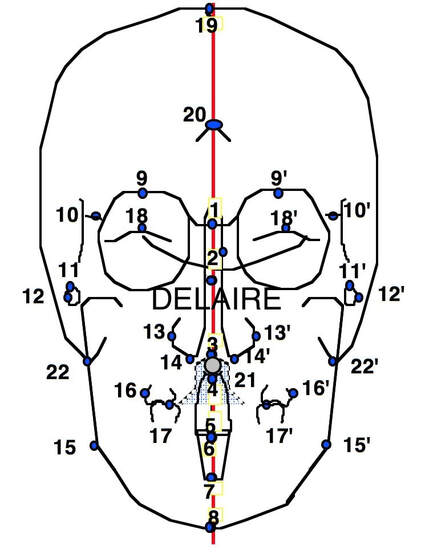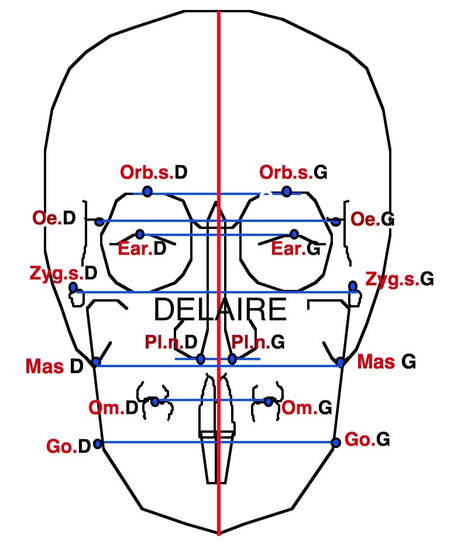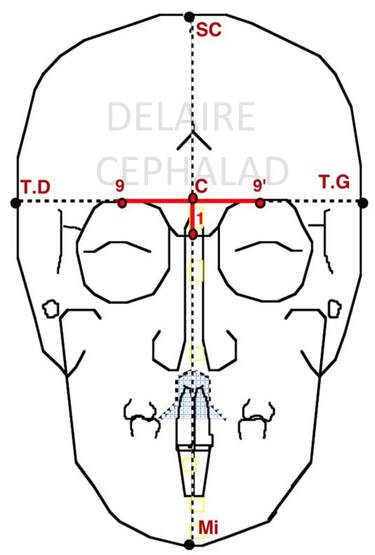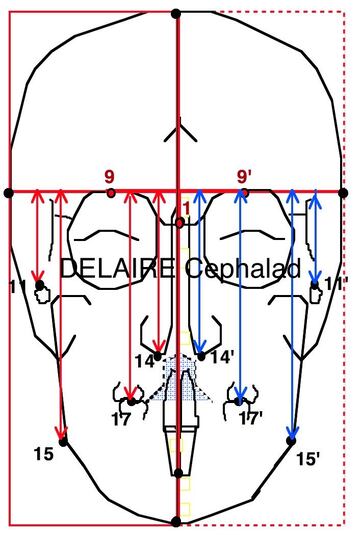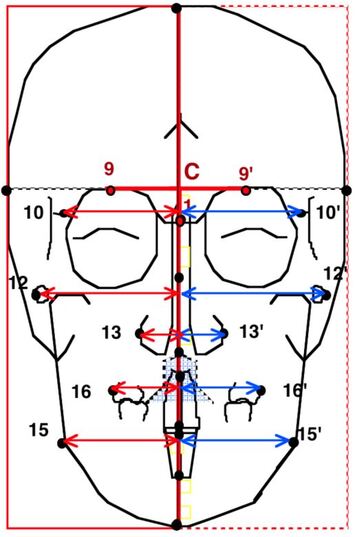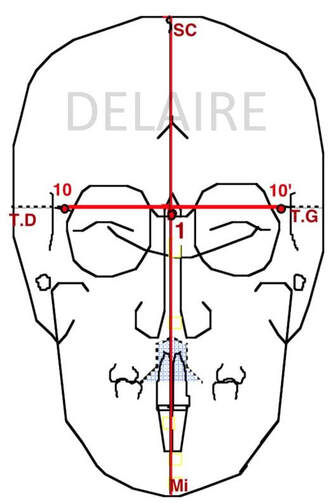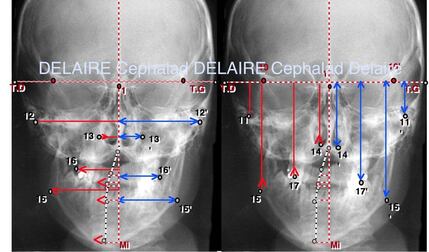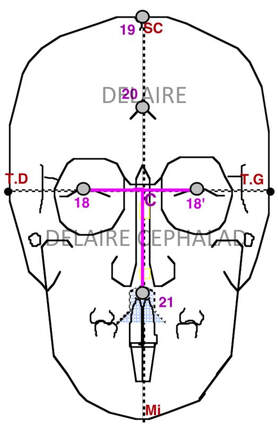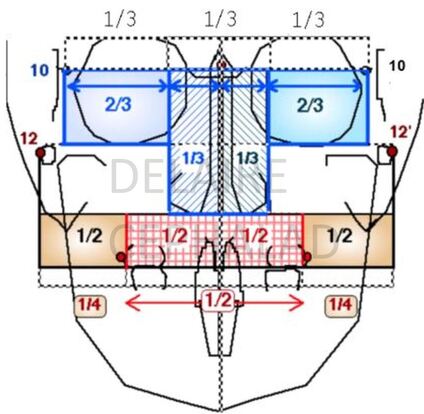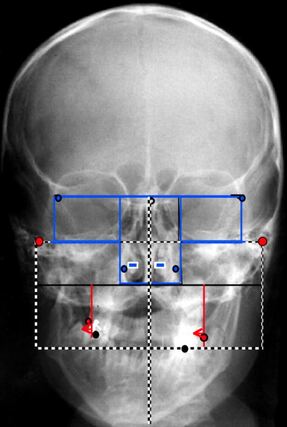FRONTAL EVALUATION
insights
Fontal analysis is an important aspect of the approach.
The normal face presents at the same time :
- a good "mirror" symmetry (transversal and vertical),
- of good proportions between its various constituents
The mirror symetry is judged in relation to the sagittal median plane of the cephalic end which normally :
- passes perfectly through all the median points (anterior and posterior).
- is well perpendicular and located in the middle of the horizontal lines joining the homologous lateral marks.
The normal face presents at the same time :
- a good "mirror" symmetry (transversal and vertical),
- of good proportions between its various constituents
The mirror symetry is judged in relation to the sagittal median plane of the cephalic end which normally :
- passes perfectly through all the median points (anterior and posterior).
- is well perpendicular and located in the middle of the horizontal lines joining the homologous lateral marks.
1/ Mirror symmetry is judged in relation to the median sagittal plane of the cephalic end which normally :
-passes perfectly through all the median points (ANTERIOR & POSTERIOR).
-is perpendicular and located in the middle of the horizontal lines joining the homologous lateral markers.
-passes perfectly through all the median points (ANTERIOR & POSTERIOR).
-is perpendicular and located in the middle of the horizontal lines joining the homologous lateral markers.
Landmarks for the Study of Cranio-Facial Symmetry.
|
-1: middle of the base of the crista galli, facing the projected image of the sphenoidal planum,
-2: middle of the perpendicular process of the ethmoid, -3: middle of the anterior nasal spine and mid-palatine suture. -4: middle of the inter-apical segment of the upper incisors. -5: Upper median inter-incisal point, -6: lower median inter-incisal point, -7: middle of the inter-apical segment of the lower incisors. -8: Middle of the bony chin, -9 and 9': Upper orbital rims, -10 and 10': fronto-malar suture midpoints , -11 and 11 ': upper edges of the zygomatic arches, -12 and 12': external edges of the zygomatic arches, -13 and 13': lateral edges of the pyriform orifices. -14 and 14': nasal floor, -15 and 15': mandibular angles, -16 and 16': external surfaces of the last molars in occlusion -17 and 17': occlusal surfaces of the molars, -18 and 18': 2 arcuata eminencia (top of the upper semi-circular canals -19: Median sagittal interparietal suture, -20: (lambda) : intersection between the parietal sutures (median sagittal) and occipito-parietal sutures, -21: (axis): middle of the topof the odontoid process of the 2nd cervical vertebra, -22' and 22': top of the mastoid process. |
The "normal" median sagittal plane of the cephalic extremity passes through all the median
ANTERIOR & POSTERIOR points
The "normal" median sagittal plane is situated in the middle of theses horizontal segments
ANTERIOR & POSTERIOR points
The "normal" median sagittal plane is situated in the middle of theses horizontal segments
|
The 'normal' median sagittal plane of the cephalic extremity is also perpendicular to the horizontal lines joining the lateral points:
-Orb.S: upper orbital rims (9 and 9'), -Oe: fronto-malar suture midpoint (10 and 10'), - Ear: 2 eminencia arcuata = summit of the upper semi-circular canals (18 and 18'), -Zyg.s: upper aspects of the zygoma arches- (11 and 11 '), -Pl.n: nasal floor 14 and 14'), -Om: occlusal surfaces of the molars (17 and 17'), -Go: mandibular angles (15 and 15'). -Mas D and G: top of the mastoid process. (22 and 22') |
|
Mirrored frontal craniofacial analysis, upper orbital rim version.
Horizontal reference line : il links 9 to 9', then is extended on each side to its intersections with the external corticals of the cranial vault (T.D and T.G). Vertical reference line : It is perpendicular to the horizontal line from point 1. It intersects the horizontal line in C. It is extended at the top: to its intersection with the upper cortical of the vault (SC), and at the bottom, to its intersection with the lower aspect of the mandible (Mi). Based on this reference line, horizontal and vertical measures can be performed for comparisons |
|
Mirrored frontal analysis, posterior craniofacial version
Horizontal reference line : it joints 18 to 18', then is extended on each side to its intersections with the external corticals of the cranial vault (T.D and T.G) Vertical reference line : Perpendicular to the horizontal line from point 21, it intersects the horizontal line in C. It is then extended upwards to the upper cortex of the vault (SC ) and down to its intersection with the lower contour of the mandible. It normally passes through specific (additional) points 19 and 20. This is used is case of important cranio facial discrepencies. |
End of section
